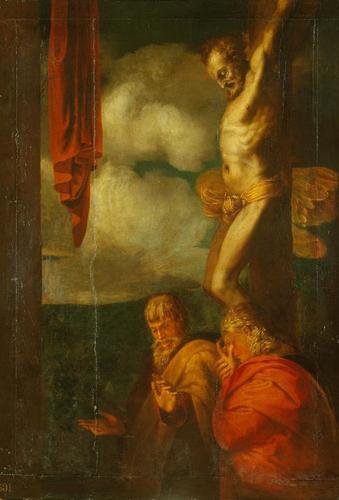A Fragment: The Bad Thief (Gestas) c. 1520-25
Oil on poplar | 123.4 x 83.5 x 3.0 cm (support, canvas/panel/stretcher external) | RCIN 402868

Perino del Vaga (Florence 1501-Rome 1547)
A Fragment: The Bad Thief (Gestas) c. 1520-25


-
The Bad Thief and The Good Thief are the only surviving fragments of an altarpiece of the Deposition of Christ. This was one of Perino’s first commissions in Rome and was for the church of Santa Maria sopra Minerva. Damaged by a flood in October 1530 and dismembered by 1600, the panels were vividly described by Vasari in his life of the artist:
‘the figures that he painted most divinely were those of the two Thieves, left fixed upon the crosses, which, besides appearing to be real dead bodies, reveal a very good mastery over muscles and nerves, which this occasion enabled him to display; wherefore, to the eyes of him who beholds them, their limbs present themselves all drawn in that violent death by the nerves, and the muscles by the nails and cords. There is, in addition, a landscape wrapped in darkness, counterfeited with much judgement and art. And if the inundation which came upon Rome after the sack [in October 1530] had not done damage to this work, covering more than half of it, its excellence would be clearly seen; but the water so softened the gesso and caused the wood to swell in such sort, that all the lower part that was soaked has peeled off too much for the picture to give any pleasure; nay it is a grief and a truly heartrending sorrow to behold it, for it would certainly have been one of the most prestigious things in all Rome.’
Something of the original appearance of this destroyed altarpiece can be reconstructed from surviving drawings, the two fragments would have hung with Christ’s cross between them, and grieving apostles below. St Peter and John the Evangelist can still be seen below the Bad Thief.
At this early stage in his career Perino was looking at and combining diverse sources. The stretched pose of the Bad Thief has been compared to the antique sculpture of Marsyas (Uffizi, Florence), also hung on a tree-like cross. The thieves have been likened to Sebastiano del Piombo’s Deposition of 1516 (Hermitage, St Petersburg), which also features a dark sky against which the crosses are silhouetted and figures dramatically lit with a silvery light. The bodies here show an attention to anatomical detail, a vigorous energy and an elongated elegance which owes much to Michelangelo. The fragments show Perino’s combination of the two very different and competing schools in Rome, the energy and elegance of Raphael and Peruzzi and the expressive and muscular grandeur of Michelangelo and Sebastiano del Piombo.
Catalogue entry adapted from The Art of Italy in the Royal Collection: Renaissance and Baroque, London, 2007Provenance
Acquired by Charles I; recorded in the Long Gallery at Whitehall in 1639 (no 36); sold from Somerset House as a pair for £40 to John Stone and others on 23 October 1651 (no 99); recovered at the Restoration and listed in the Room between the Long Gallery and the Withdrawing Room at Whitehall in 1666 (no 90)
-
Medium and techniques
Oil on poplar
Measurements
123.4 x 83.5 x 3.0 cm (support, canvas/panel/stretcher external)
138.9 x 99.3 x 6.5 cm (frame, external)
Category
Object type(s)
Other number(s)
Alternative title(s)
The unrepentant thief on the cross








